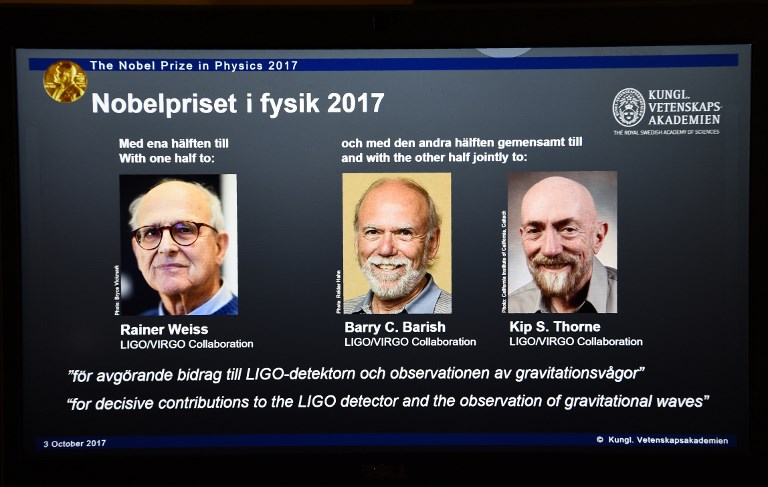
Around 1.3 billion years ago, in a far-flung corner of the universe, two black holes — the densest, most destructive forces known to nature — collided with each other.
A hundred years ago, Albert Einstein predicted that such a massive collision would distort the very fabric of space and time itself. Like a stone cast into a pond, the cataclysmic disturbance would ripple outward at the speed of light, filling the ocean of the universe with gravitational waves. Einstein, however, never thought it would be possible to detect such waves.
In a massive achievement of human ingenuity and patience, scientists announced in 2016 that they had detected these waves as they slid through the Earth. (Since then, they’ve detected them three more times.) And Tuesday, their effort to record gravitational waves for the first time — a decades-long collaboration involving thousands of scientists around the globe — has been awarded the Nobel Prize in physics.
A Nobel can only go to a maximum of three laureates, however, and so this one went to physicists Rainer Weiss, Kip Thorne, and Barry Barish. They pioneered LIGO, or the Laser Interferometer Gravitational-Wave Observatory, the scientific project that made gravitational wave detection possible.
In the 1970s, Weiss and Thorne dreamed up the initial idea to detect gravitational waves. When Barish took over as lead of the project in 1994, he oversaw the crucial decision to increase the power and sensitivity of the detectors, which allowed for the final discovery. Weiss was awarded one-half of the 9,000,000 Swedish kroner prize (about $1.1 million). Thorne and Barish split the second half.
Though these three got the prize, know that LIGO was the result of thousands of scientists working world over in collaboration for decades. (Critics argue that giving the award to three individuals distorts the public’s perception of how science actually gets done.)
And they didn’t just answer a 100-year-old question — they launched a whole new branch of science.
Right now our telescopes can only see objects that emit electromagnetic radiation — visible light, X-rays, gamma rays, and so on. But some objects, like colliding black holes or the smoking gun of the Big Bang, don't emit any electromagnetic radiation. Instead, they emit gravity. And that's why, with gravitational wave astronomy, hard-to-detect objects in the universe — like black holes and neutron stars — may soon come into clearer focus.
“We now witness the dawn of a new field: gravitational wave astronomy,” Nils Mårtensson, chair of the Nobel Committee for Physics, said at the announcement Tuesday. “This will teach us about the most violent processes in the universe, and it will lead to new insights into the nature of extreme gravity.”
Gravitational waves, explained
Just as sound waves disturb the air to make noise, gravitational waves disturb the fabric of spacetime to push and pull matter as if it existed in a funhouse mirror. If a gravitational wave passed through you, you’d see one of your arms grow longer than the other. If you were wearing a watch on each wrist, you'd see them tick out of sync.
Gravitational waves are generated by any movement of mass. "For instance, if I wave my arms really crazily, I would generate gravitational waves," Sarah Caudill, a physicist at the University of Wisconsin Milwaukee, told me in 2016.
But there’s no way to detect gravitational waves that faint. For now, our sensors need a really, really loud source — like the collision of two black holes.
Two black holes colliding unleash a loud thunderclap of gravity. If you were near the black holes when they collided, you’d see the universe expand and contract like you were living inside a funhouse mirror. But by the time they reach the Earth — like ripples nearing the edge of a pond — they grew faint.
One of the waves LIGO heard (around Christmas 2015) was around 0.7 attometers tall. An attometer is 10^-18 meters. That’s so, so unbelievably tiny. It’s much smaller than an atom. The following GIF starts out showing the width of an atom, and then zooms down to 10^-18. It’s amazing that we were able to detect something that small.
And all of this took decades of work: The theory LIGO tested was developed in the early 20th century; the LIGO project was dreamt up in the 1970s and began in earnest in the 1980s. It was first turned on in 2002 and it took an international effort to detect and confirm the waves in 2016. It’s having a big moment now, but it goes to show that big breakthroughs have deep roots, and science is ultimately a collaborative, multigenerational effort.
How to catch a gravitational wave
LIGO, which is funded by the National Science Foundation, consists of two enormous science experiments: One is in Louisiana; the other is located in Washington state. Both are massive L-shaped tubes. Each arm of the tube is 2.5 miles long.
These instruments are called interferometers, and their design is based on work Weiss conducted in the 1960s. Here’s how they work.
During the experiments, a laser beam is split equally between the two arms. At the end of each arm is a mirror, which reflects the laser back to the starting point. What LIGO is looking for is evidence that gravitational waves are distorting spacetime enough that one of the arms becomes temporarily longer than the other.
These changes can be incredibly tiny, since LIGO is sensitive enough to detect a change in distance smaller than the width of a proton.
"Each detector is like a violin string, and we’re waiting for a gravitational wave to ‘pluck’ each detector string," Dave Reitze, the current executive director of the LIGO Project, said last year.
/cdn.vox-cdn.com/uploads/chorus_asset/file/9379943/fig_fy_en_17_LIGO.jpg)
If a wave is detected in one of the sites, it has to be corroborated with the other site (to make sure it's not just a false signal from local automobile traffic or other disturbances).
LIGO was first set up in 2002, and for years it found nothing. In 2010 it was shut down for an upgrade, which extended its range. When it was turned back on in 2015, it almost immediately began hearing the waves.
By listening in on these loud waves, the scientists are able to reconstruct the cataclysmic events that created them. Just from the two detectors, scientists can determine the mass of the black holes and how far away they are, roughly map where in the sky they are, and distill some information about the shape of their orbits.
This past year, a third detector, an Italy-based machine called VIRGO, turned on and also began sensing gravitational waves. In September, both VIRGO and LIGO confirmed a new set of gravitational waves emanating from the smoking gun of two black holes that collided 1.8 billion years ago. It means now we have a global network for gravitational wave astronomy. And it’s only going to improve.
What other cool things can we learn from gravitational wave astronomy?
For now, LIGO can’t be pointed at a region in the sky to search for gravitational waves. Rather, it just hears the gravitational waves that are passing through Earth at any particular moment. And, at first, it didn’t do a great job of pinpointing where these waves were coming from.
/cdn.vox-cdn.com/uploads/chorus_asset/file/6653455/Localization%20Comparison%201.jpg)
But now that VIRGO has been activated, scientists can much more accurately pinpoint the source in the sky. In the following graphic, the blue region represents where LIGO alone thought the waves were coming from. The green region shows how VIRGO made the guess much more precise. “Overall, the volume of universe that is likely to contain the source shrinks by more than a factor of 20,” the LIGO-VIRGO collaboration explained in a press release.
/cdn.vox-cdn.com/uploads/chorus_asset/file/9379901/DKvoSX5XUAEXNn7.jpg)
These announcements are going to become more commonplace. Detectors have confirmed four gravitational waves, and many more are certain to come.
And, again, this is a whole new field of astronomy, a whole new eyepiece upon which to observe the universe. Here are some cool things the next era of gravitational wave astronomy could accomplish.
1) Seeing farther back in time
One problem with our current fleet of telescopes is that they can’t see back to the very early universe.
"If you look with visible light as far as we can look in the universe, the universe is no longer transparent; it becomes opaque," Cliff Burgess, a particle physicist at McMaster University, told me in 2016. "Almost nothing is opaque to gravity." With LIGO, we could potentially listen in on the gravitational waves emanating from the early universe, or even the Big Bang, and gain a better understand of how it formed.
2) Improving on Einstein’s theory of general relativity
A century ago, Einstein published his theory of general relativity, and it has dominated our understanding of gravity ever since. But physicists (and Einstein himself) have long speculated the theory isn’t complete, as it doesn’t play well with the laws of quantum mechanics. Gravitational waves could help physicists put general relativity to harder and harder tests to see where it fails.
"We’ve found that these black holes are completely consistent with Einstein’s theory that he formed 100 years ago," Caudill says. "So that’s cool, but as we get more and more detections, we can probe his theory even deeper, and maybe expose holes in it."
3) Discovering new neutron stars
Neutron stars are the extremely dense cores of collapsed stars that can emit large amounts of gravity. What’s cool about them is that they also produce light. "If you can see an event like neutron stars colliding, or a black hole and a neutron star colliding," with LIGO, Caudill says, you can then point traditional telescopes at them to watch the light show.
4) Learning how common it is for black holes to orbit one another
Before the February announcement, no scientist had observational proof that two black holes could orbit each other. Now we’ve seen two pairs of them doing it. Gravitational wave astronomy will help us understand how many of these pairs exist in the universe.
5) Finding the source of dark matter
Dark matter is theorized to make up 27 percent of all the matter in the universe. But we’ve never seen dark matter (it’s dark!), and we don’t know where it comes from.
Matter creates gravity. Perhaps gravitational waves can help us trace the origins of dark matter. It could exist in the form of many tiny black holes. It could be the remnants of "primordial" black holes created at the beginning of the universe. We don’t know.
6) Finding new, weird celestial objects
The universe is a big, dark place.
"We might find sources [of gravity] we were not expecting," Avi Loeb, a Harvard theoretical physicist, said. "That would be the most exciting."
Perhaps we’ll find evidence of "cosmic strings," hypothesized weird wrinkles in spacetime containing a massive amount of energy. And the chances of finding these strange new objects only increases as the power of LIGO increases and its counterparts come online.
It will be like "going from simple Galileo telescopes to the types of telescopes you put on top of mountains," David Reitze says. "For the next 50 years, this is going to be a really exciting field."



No comments:
Post a Comment